Development of Washable Silver Printed Textile Electrodes for Long-Term ECG Monitoring
Abstract
1. Introduction
2. Materials and Methods
2.1. Materials
2.2. Textile Electrode Development
2.3. Electrical and Microscopy Characterization
2.4. ECG Measurements and Signal Evaluation Method
2.5. Washing, Environmental, and Stretching Durability Tests
3. Results and Discussion
3.1. Electrical and Morphological Properties
3.2. ECG Signal Acquired Using Textile Electrodes
3.3. Effect of Holding Pressure Level on ECG Signal Quality
3.4. Effect of Body Motion on the ECG Quality
3.5. Washing and Stretching Durability
3.6. ECG Signal Acquired after Electrode Washing
4. Conclusions
Author Contributions
Funding
Conflicts of Interest
References
- Wang, Y.; Deepu, C.J.; Lian, Y. A computationally efficient QRS detection algorithm for wearable ECG sensors. In Proceedings of the 2011 Annual International Conference of the IEEE Engineering in Medicine and Biology Society; IEEE: Boston, MA, USA, 2011; pp. 5641–5644. [Google Scholar]
- Pani, D.; Achilli, A.; Bonfiglio, A. Survey on Textile Electrode Technologies for Electrocardiographic (ECG) Monitoring, from Metal Wires to Polymers. Adv. Mater. Technol. 2018, 3, 1800008. [Google Scholar] [CrossRef]
- Gonzales, R.; Walker, L.; Keller, K.; Beckman, D.; Goodell, H.; Wright, G.; Rhone, C.; Emery, A.; Gupta, R. Textile sensor system for electrocardiogram monitoring. In Proceedings of the IEEE Virtual Conference on Applications of Commercial Sensors (VCACS), Raleigh, NC, USA, 15 March–15 October 2015; pp. 1–4. [Google Scholar]
- Shafti, A.; Manero, R.B.R.; Borg, A.M.; Althoefer, K.; Howard, M.J. Designing embroidered electrodes for wearable surface electromyography. In Proceedings of the 2016 IEEE International Conference on Robotics and Automation (ICRA), Stockholm, Sweden, 16–21 May 2016; IEEE: Stockholm, Sweden, 2016; pp. 172–177. [Google Scholar]
- Löfhede, J.; Seoane, F.; Thordstein, M. Textile Electrodes for EEG Recording—A Pilot Study. Sensors 2012, 12, 16907–16919. [Google Scholar] [CrossRef] [PubMed]
- Sibinski, M.; Jakubowska, M.; Sloma, M. Flexible Temperature Sensors on Fibers. Sensors 2010, 10, 7934–7946. [Google Scholar] [CrossRef] [PubMed]
- Min, H.; Yun, Y.H. Shin Simplified Structural Textile Respiration Sensor Based on Capacitive Pressure Sensing Method. IEEE Sens. J. 2014, 14, 3245–3251. [Google Scholar] [CrossRef]
- Lou, C.; Li, R.; Li, Z.; Liang, T.; Wei, Z.; Run, M.; Yan, X.; Liu, X. Flexible graphene electrodes for prolonged dynamic ECG monitoring. Sensors 2016, 16, 1833. [Google Scholar] [CrossRef] [PubMed]
- Ankhili, A.; Tao, X.; Cochrane, C.; Coulon, D.; Koncar, V. Washable and Reliable Textile Electrodes Embedded into Underwear Fabric for Electrocardiography (ECG) Monitoring. Materials 2018, 11, 256. [Google Scholar] [CrossRef] [PubMed]
- Nemati, E.; Deen, M.; Mondal, T. A wireless wearable ECG sensor for long-term applications. IEEE Commun. Mag. 2012, 50, 36–43. [Google Scholar] [CrossRef]
- Micheal, R. Neuman Biopotential amplifiers. In Medical Instrumentation-Application and Design; John Wiley & Sons: New York, NY, USA, 2010; pp. 241–286. ISBN 13 978-0-471-67600-3. [Google Scholar]
- Yu, Y.; Zhang, J.; Liu, J. Biomedical Implementation of Liquid Metal Ink as Drawable ECG Electrode and Skin Circuit. PLoS ONE 2013, 8, e58771. [Google Scholar] [CrossRef]
- Ribeiro, D.M.D.; Fu, L.S.; Carlos, L.A.D.; Cunha, J.P.S. A Novel Dry Active Biosignal Electrode Based on an Hybrid Organic-Inorganic Interface Material. IEEE Sens. J. 2011, 11, 2241–2245. [Google Scholar] [CrossRef]
- Xu, P.J.; Zhang, H.; Tao, X.M. Textile-structured electrodes for electrocardiogram. Text. Prog. 2008, 40, 183–213. [Google Scholar] [CrossRef]
- Meziane, N.; Webster, J.G.; Attari, M.; Nimunkar, A.J. Dry electrodes for electrocardiography. Physiol. Meas. 2013, 34, R47–R69. [Google Scholar] [CrossRef]
- Vojtech, L.; Bortel, R.; Neruda, M.; Kozak, M. Wearable Textile Electrodes for ECG Measurement. Adv. Electr. Electron. Eng. 2013, 11, 410–414. [Google Scholar] [CrossRef]
- Song, H.Y.; Lee, J.H.; Kang, D.; Cho, H.; Cho, H.S.; Lee, J.W.; Lee, Y.J. Textile electrodes of jacquard woven fabrics for biosignal measurement. J. Text. Inst. 2010, 101, 758–770. [Google Scholar] [CrossRef]
- Kannaian, T.; Neelaveni, R.; Thilagavathi, G. Design and development of embroidered textile electrodes for continuous measurement of electrocardiogram signals. J. Ind. Text. 2013, 42, 303–318. [Google Scholar] [CrossRef]
- Ankhili, A.; Tao, X.; Cochrane, C.; Koncar, V.; Coulon, D.; Tarlet, J.M. Comparative study on conductive knitted fabric electrodes for long-term electrocardiography monitoring: Silver-plated and PEDOT:PSS coated fabrics. Sensors 2018, 18, 890. [Google Scholar] [CrossRef] [PubMed]
- Das, P.S.; Kim, J.W.; Park, J.Y. Fashionable wrist band using highly conductive fabric for electrocardiogram signal monitoring. J. Ind. Text. 2019, 49, 243–261. [Google Scholar] [CrossRef]
- Pani, D.; Dessi, A.; Saenz-Cogollo, J.F.; Barabino, G.; Fraboni, B.; Bonfiglio, A. Fully Textile, PEDOT:PSS Based Electrodes for Wearable ECG Monitoring Systems. IEEE Trans. Biomed. Eng. 2016, 63, 540–549. [Google Scholar] [CrossRef]
- Lee, H.J.; Hwang, S.H.; Yoon, H.N.; Lee, W.K.; Park, K.S. Heart rate variability monitoring during sleep based on capacitively coupled textile electrodes on a bed. Sensors 2015, 15, 11295–11311. [Google Scholar] [CrossRef]
- Babusiak, B.; Borik, S.; Balogova, L. Textile electrodes in capacitive signal sensing applications. Meas. J. Int. Meas. Confed. 2018, 114, 69–77. [Google Scholar] [CrossRef]
- Chamadiya, B.; Mankodiya, K.; Wagner, M.; Hofmann, U.G. Textile-based, contactless ECG monitoring for non-ICU clinical settings. J. Ambient Intell. Humaniz. Comput. 2013, 4, 791–800. [Google Scholar] [CrossRef]
- Lee, J.S.; Heo, J.; Lee, W.K.; Lim, Y.G.; Kim, Y.H.; Park, K.S. Flexible capacitive electrodes for minimizing motion artifacts in ambulatory electrocardiograms. Sensors 2014, 14, 14732–14743. [Google Scholar] [CrossRef]
- Weder, M.; Hegemann, D.; Amberg, M.; Hess, M.; Boesel, L.F.; Abächerli, R.; Meyer, V.R.; Rossi, R.M. Embroidered electrode with silver/titanium coating for long-term ECG monitoring. Sensors 2015, 15, 1750–1759. [Google Scholar] [CrossRef] [PubMed]
- Lee, J.W.; Yun, K.S. ECG monitoring garment using conductive carbon paste for reduced motion artifacts. Polymers 2017, 9, 439. [Google Scholar] [CrossRef]
- Yapici, M.K.; Alkhidir, T.; Samad, Y.A.; Liao, K. Graphene-clad textile electrodes for electrocardiogram monitoring. Sens. Actuators B Chem. 2015, 221, 1469–1474. [Google Scholar] [CrossRef]
- Yapici, M.K.; Alkhidir, T.E. Intelligent medical garments with graphene-functionalized smart-cloth ECG sensors. Sensors 2017, 17, 875. [Google Scholar] [CrossRef] [PubMed]
- Boehm, A.; Yu, X.; Neu, W.; Leonhardt, S.; Teichmann, D. A Novel 12-Lead ECG T-Shirt with Active Electrodes. Electronics 2016, 5, 75. [Google Scholar] [CrossRef]
- An, X.; Tangsirinaruenart, O.; Stylios, G.K. Investigating the performance of dry textile electrodes for wearable end-uses. J. Text. Inst. 2019, 110, 151–158. [Google Scholar] [CrossRef]
- Xiong, Y.; Tao, X. Compression Garments for Medical Therapy and Sports. Polymers 2018, 10, 663. [Google Scholar] [CrossRef]
- Tong, W.; Kan, C.; Yang, H. Sensitivity analysis of wearable textiles for ECG sensing. In Proceedings of the 2018 IEEE EMBS International Conference on Biomedical & Health Informatics (BHI), Las Vegas, NV, USA, 4–7 March 2018; IEEE: Las Vegas, NV, USA, 2018; pp. 157–160. [Google Scholar]
- Kazani, I.; Hertleer, C.; de Mey, G.; Schwarz, A.; Guxho, G.; van Langenhove, L. Electrical conductive textiles obtained by screen printing. Fibres Text. East. Eur. 2012, 90, 57–63. [Google Scholar]
- Yokus, M.A.; Jur, J.S. Fabric-Based Wearable Dry Electrodes for Body Surface Biopotential Recording. IEEE Trans. Biomed. Eng. 2016, 63, 423–430. [Google Scholar] [CrossRef]
- Tallgren, P.; Vanhatalo, S.; Kaila, K.; Voipio, J. Evaluation of commercially available electrodes and gels for recording of slow EEG potentials. Clin. Neurophysiol. 2005, 116, 799–806. [Google Scholar] [CrossRef] [PubMed]
- Marozas, V.; Petrenas, A.; Daukantas, S.; Lukosevicius, A. A comparison of conductive textile-based and silver/silver chloride gel electrodes in exercise electrocardiogram recordings. J. Electrocardiol. 2011, 44, 189–194. [Google Scholar] [CrossRef] [PubMed]
- Tsukada, Y.T.; Tokita, M.; Murata, H.; Hirasawa, Y.; Yodogawa, K.; Iwasaki, Y.-K.; Asai, K.; Shimizu, W.; Kasai, N.; Nakashima, H.; et al. Validation of wearable textile electrodes for ECG monitoring. Heart Vessel. 2019, 34, 1203–1211. [Google Scholar] [CrossRef] [PubMed]
- De Capua, C.; Meduri, A.; Morello, R. A smart ECG measurement system based on web-service-oriented architecture for telemedicine applications. IEEE Trans. Instrum. Meas. 2010, 59, 2530–2538. [Google Scholar] [CrossRef]
- Trindade, I.G.; Martins, F.; Baptista, P. High electrical conductance poly(3,4-ethylenedioxythiophene) coatings on textile for electrocardiogram monitoring. Synth. Met. 2015, 210, 179–185. [Google Scholar] [CrossRef]
- Taji, B.; Shirmohammadi, S.; Groza, V.; Bolic, M. An ECG monitoring system using conductive fabric. In Proceedings of the MeMeA 2013-IEEE International Symposium on Medical Measurements and Applications, Gatineau, QC, Canada, 4–5 May 2013; pp. 309–314. [Google Scholar] [CrossRef]
- Chlaihawi, A.A.; Narakathu, B.B.; Emamian, S.; Bazuin, B.J.; Atashbar, M.Z. Development of printed and flexible dry ECG electrodes. Sens. Bio-Sens. Res. 2018, 20, 9–15. [Google Scholar] [CrossRef]
- Dupre, A.; Vincent, S.; Iaizzo, P.A. Basic ECG theory, Recordings, and interpretation. In Handbook of Cardiac Anatomy, Physiology, and Devices; Humana Press: Totowa, NJ, USA, 2005; ISBN 978-1-59259-835-9. [Google Scholar]
- Liu, Z.; Liu, X. Progress on Fabric Electrodes Used in ECG Signals Monitoring. J. Text. Sci. Technol. 2015, 1, 110–117. [Google Scholar] [CrossRef][Green Version]
- Lee, H.J.; Jeong, S.H. Bacteriostasis and Skin Innoxiousness of Nanosize Silver Colloids on Textile Fabrics. Text. Res. J. 2005, 75, 551–556. [Google Scholar] [CrossRef]
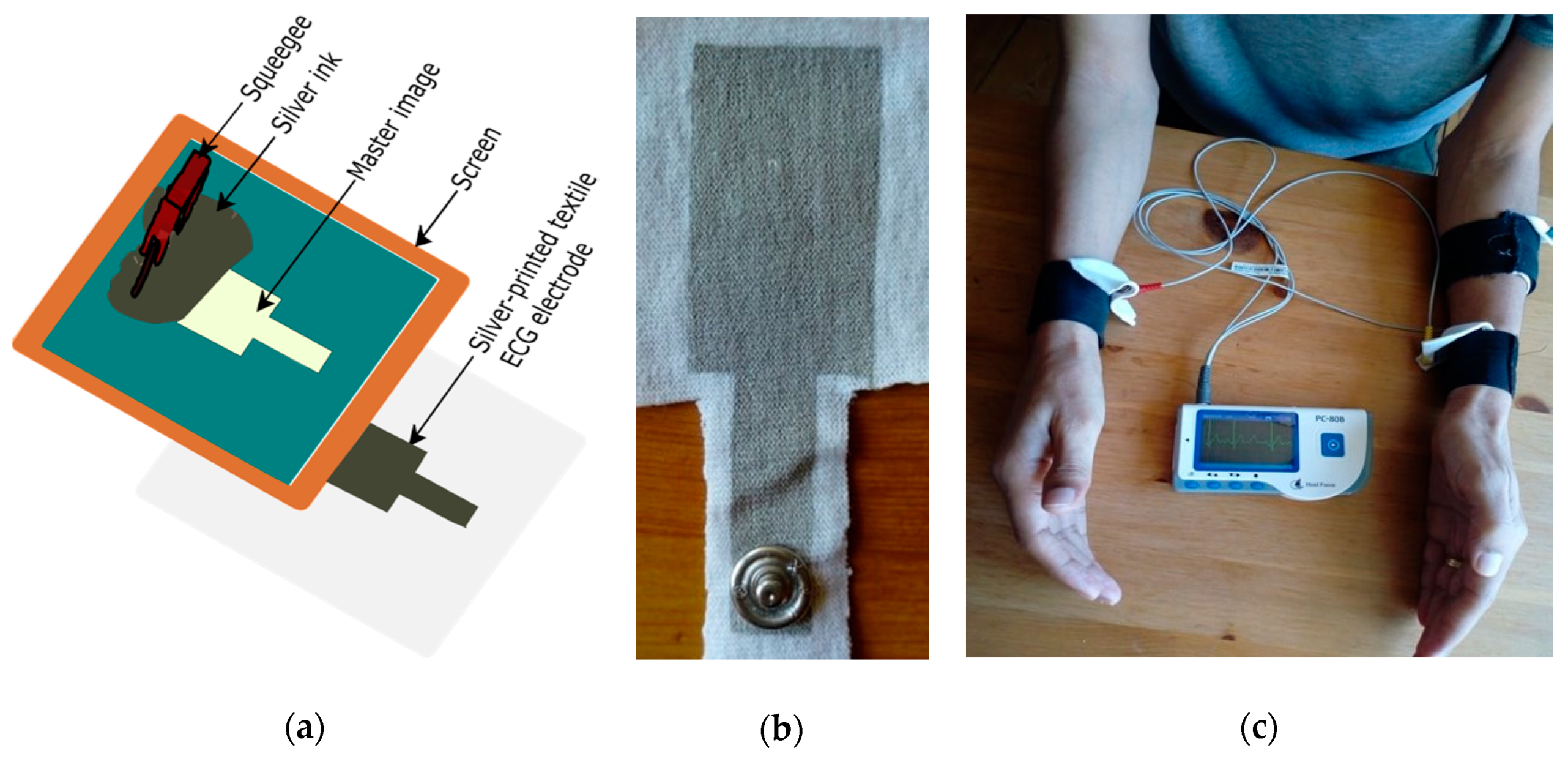
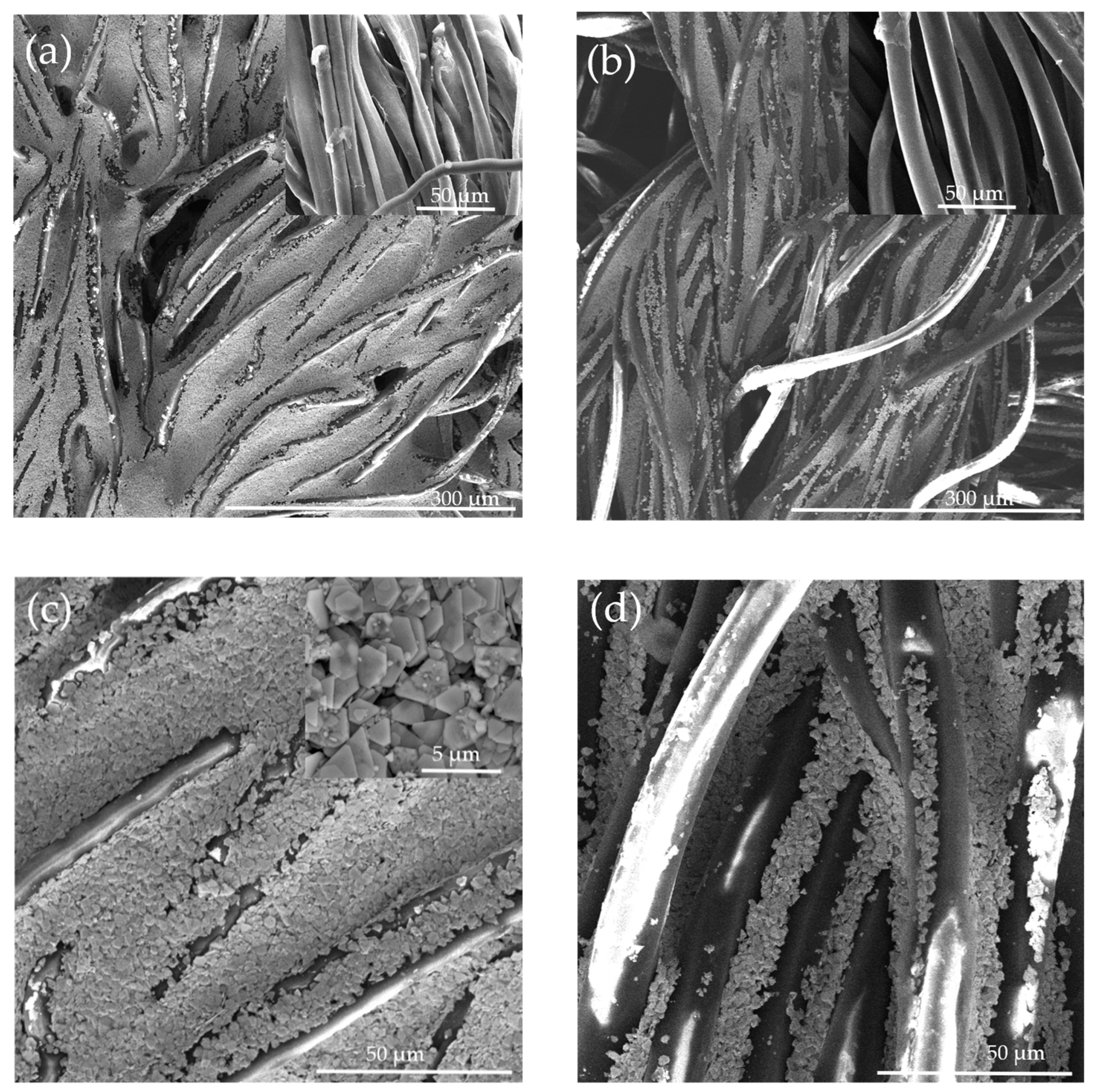

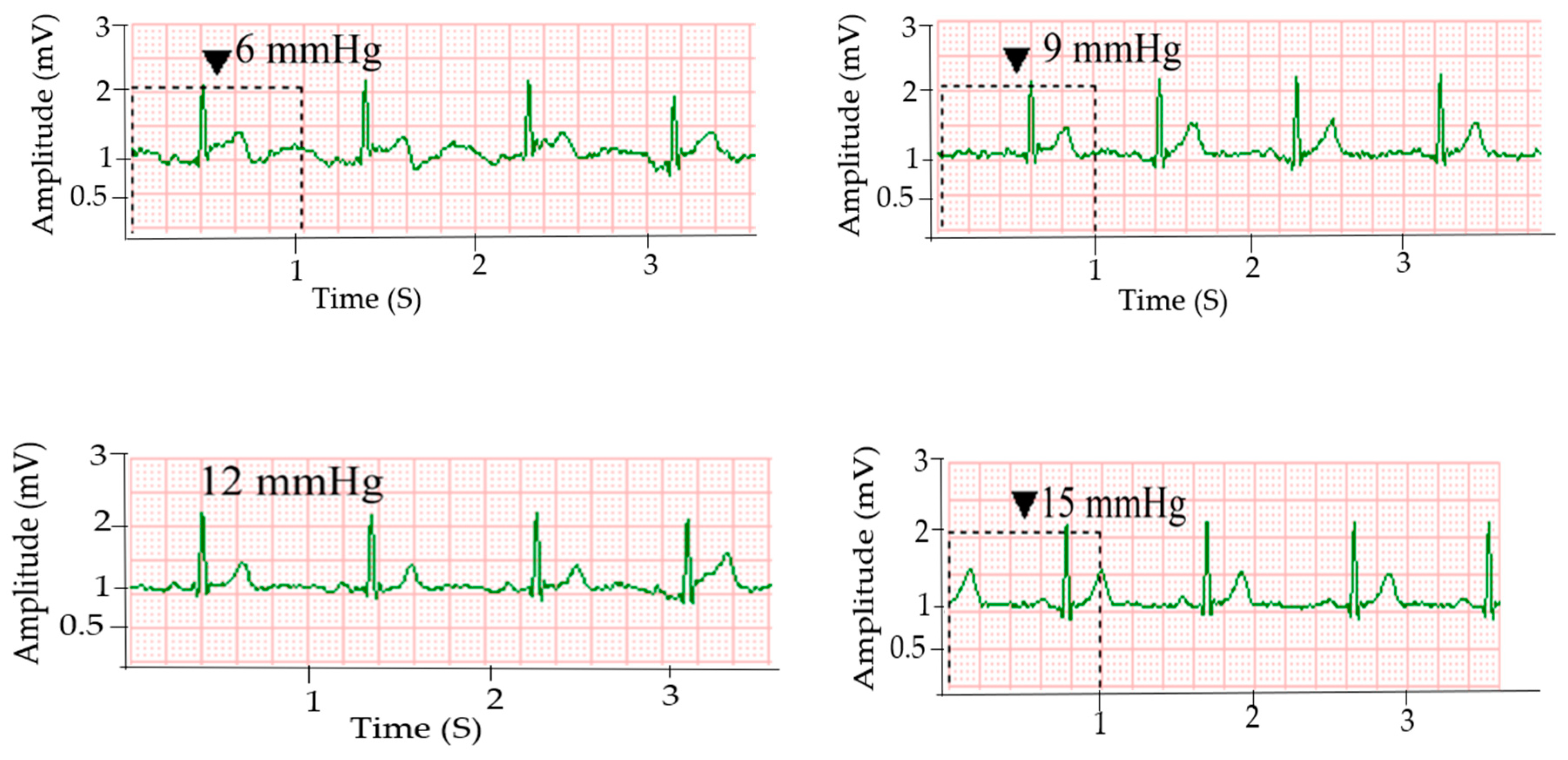
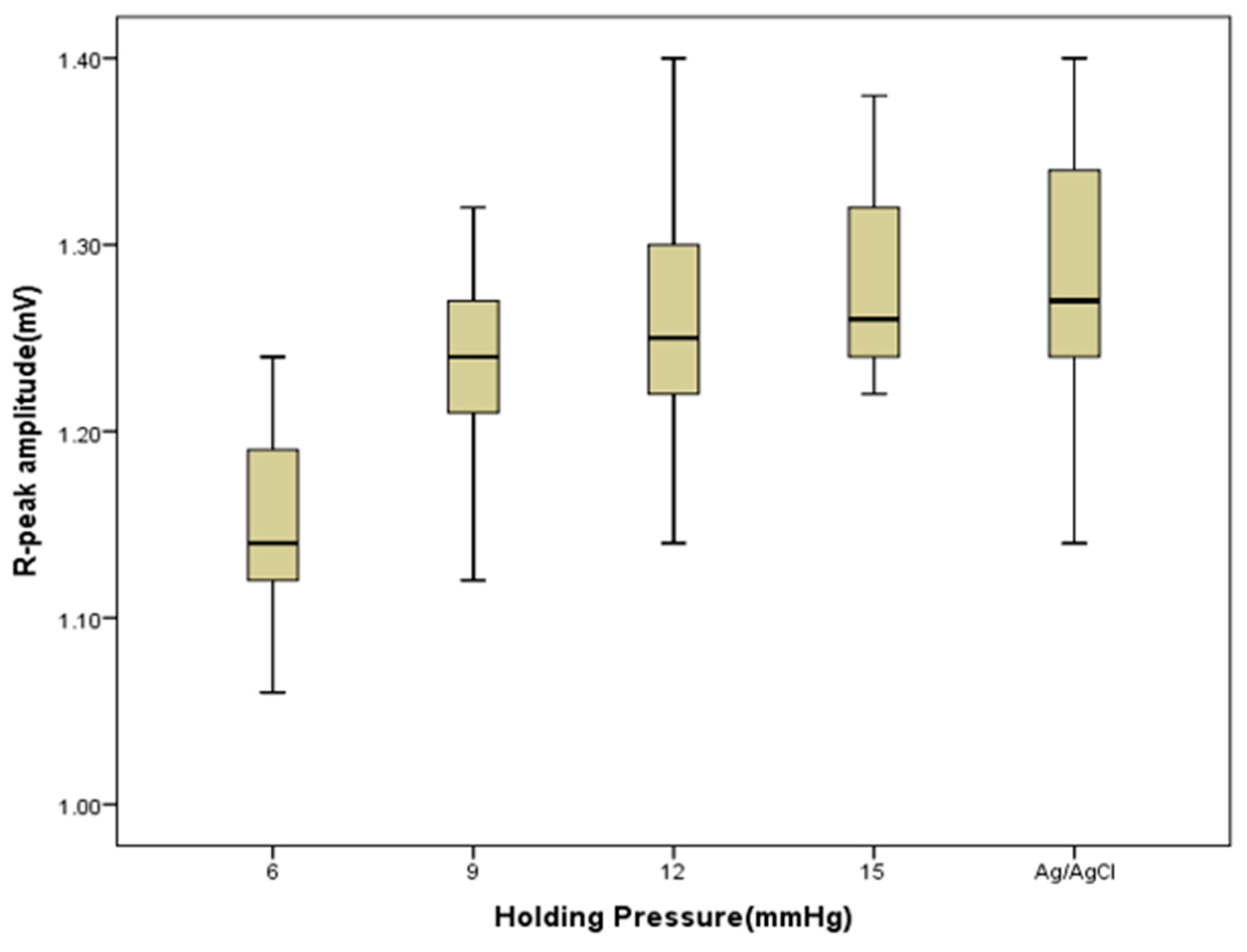
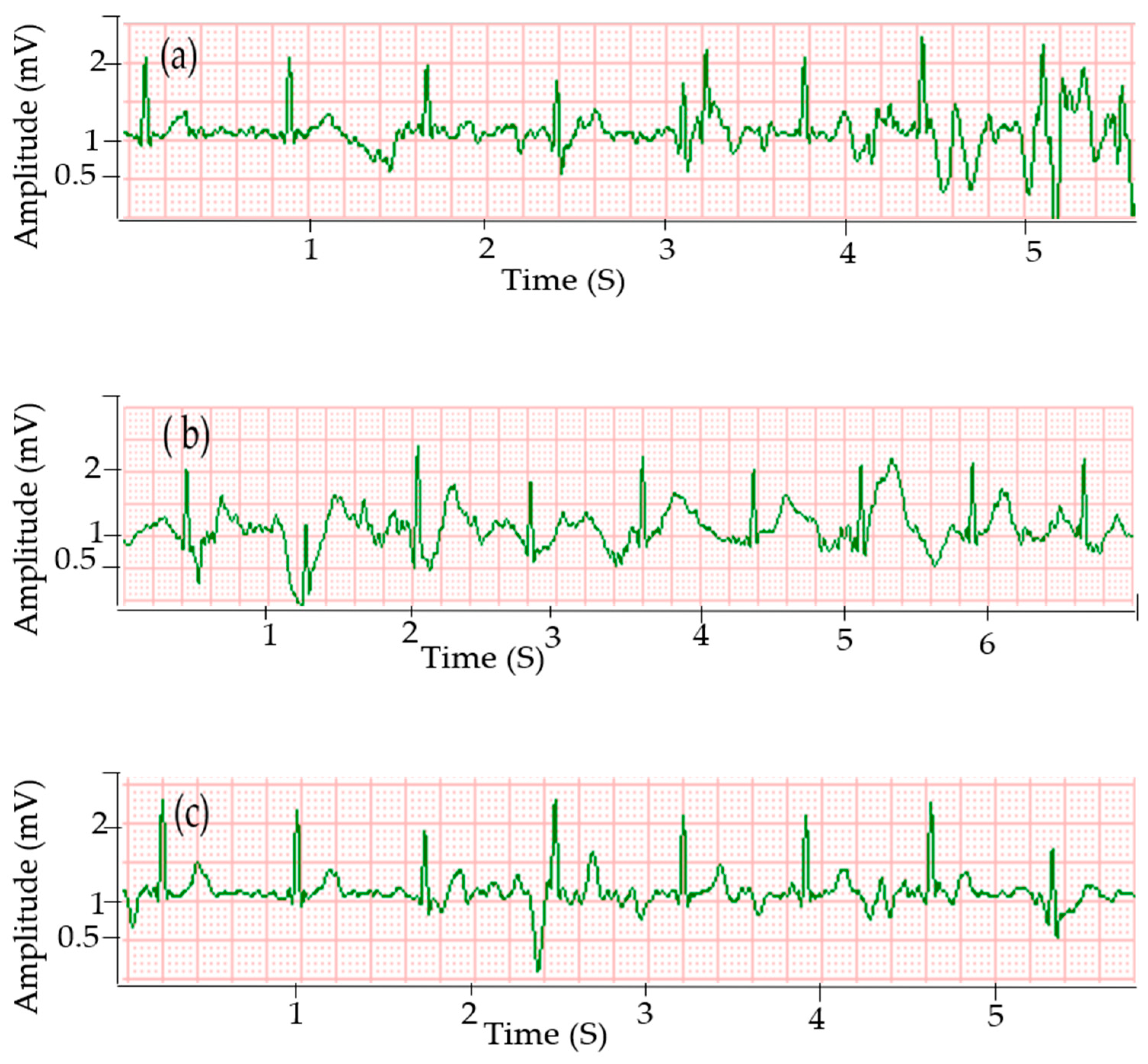
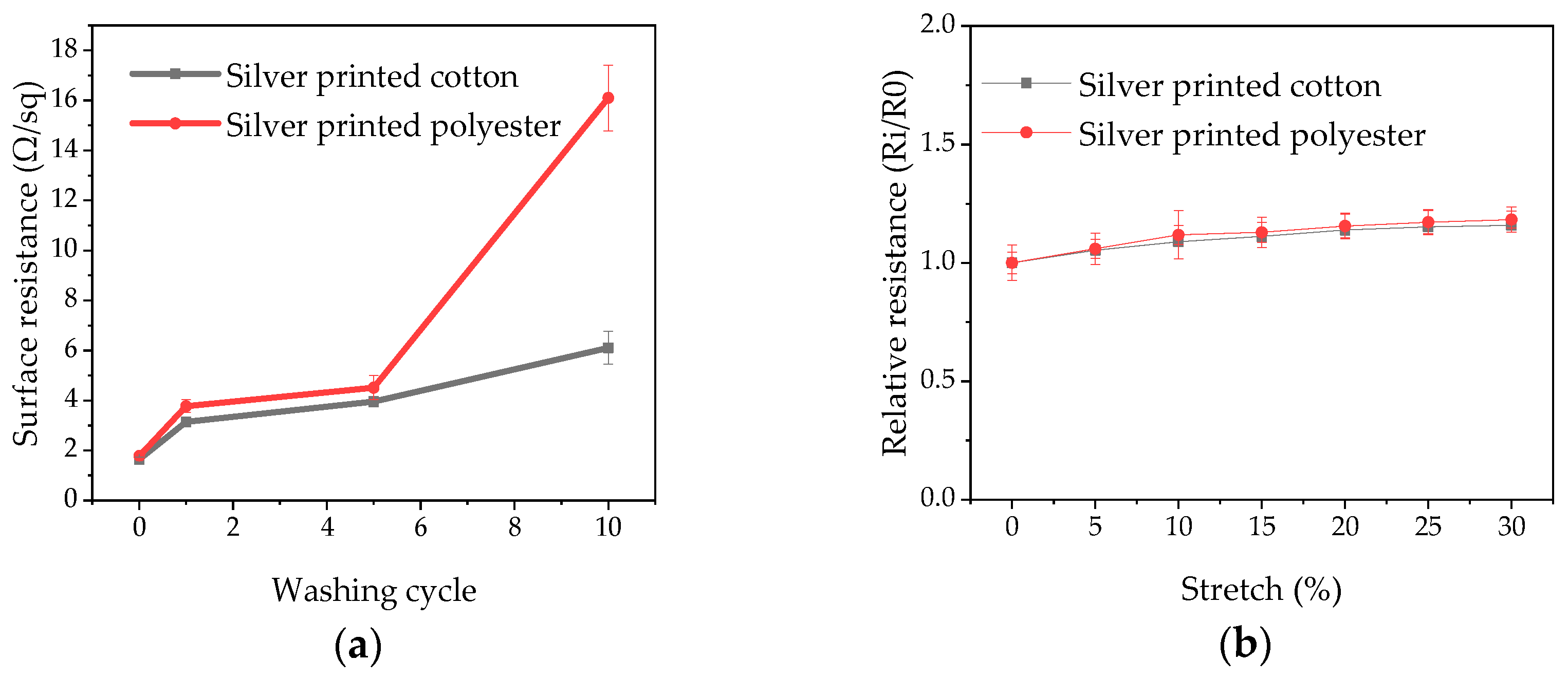


| Waveforms and Intervals | Electrode Type | ||
|---|---|---|---|
| Silver Printed Cotton | Silver Printed Polyester | Ag/AgCl | |
| P (mV) | 0.09 ± 0.01 | 0.09 ± 0.02 | 0.09 ± 0.01 |
| R-peak amplitude (mV) | 1.28 ± 0.05 | 1.26 ± 0.04 | 1.29 ± 0.05 |
| T (mV) | 0.35 ± 0.04 | 0.35 ± 03 | 0.35 ± 0.03 |
| PR (ms) | 158 ± 4 | 154 ± 4 | 158 ± 4 |
| QRS (ms) | 93 ± 1 | 93 ± 1 | 93 ± 1 |
| QT (ms) | 346 ± 8 | 336 ± 8 | 348 ± 8 |
| SNR (dB) | 33.10 ± 1.31 | 30.17 ± 1.43 | 33.52 ± 1.30 |
| Hear rate (bpm) | 75 ± 1 | 73 ± 2 | 76 ± 1 |
| Subject | HR (bpm) | R-R Interval (ms) | ||||
|---|---|---|---|---|---|---|
| Silver Printed Cotton | Silver Printed Polyester | Ag/AgCl | Silver Printed Cotton | Silver Printed Polyester | Ag/AgCl | |
| 1 | 73 | 75 | 76 | 736 ± 18 | 756 ± 20 | 762 ± 16 |
| 2 | 80 | 79 | 79 | 760 ± 23 | 712 ± 40 | 736 ± 16 |
| 3 | 82 | 84 | 82 | 761 ± 27 | 720 ± 27 | 727 ± 39 |
| 4 | 80 | 80 | 82 | 763 ± 20 | 768 ± 28 | 736 ± 20 |
| 5 | 90 | 92 | 93 | 643 ± 12 | 653 ± 14 | 641 ± 15 |
| 6 | 78 | 77 | 77 | 797 ± 49 | 782 ± 53 | 807 ± 45 |
Publisher’s Note: MDPI stays neutral with regard to jurisdictional claims in published maps and institutional affiliations. |
© 2020 by the authors. Licensee MDPI, Basel, Switzerland. This article is an open access article distributed under the terms and conditions of the Creative Commons Attribution (CC BY) license (http://creativecommons.org/licenses/by/4.0/).
Share and Cite
Nigusse, A.B.; Malengier, B.; Mengistie, D.A.; Tseghai, G.B.; Van Langenhove, L. Development of Washable Silver Printed Textile Electrodes for Long-Term ECG Monitoring. Sensors 2020, 20, 6233. https://doi.org/10.3390/s20216233
Nigusse AB, Malengier B, Mengistie DA, Tseghai GB, Van Langenhove L. Development of Washable Silver Printed Textile Electrodes for Long-Term ECG Monitoring. Sensors. 2020; 20(21):6233. https://doi.org/10.3390/s20216233
Chicago/Turabian StyleNigusse, Abreha Bayrau, Benny Malengier, Desalegn Alemu Mengistie, Granch Berhe Tseghai, and Lieva Van Langenhove. 2020. "Development of Washable Silver Printed Textile Electrodes for Long-Term ECG Monitoring" Sensors 20, no. 21: 6233. https://doi.org/10.3390/s20216233
APA StyleNigusse, A. B., Malengier, B., Mengistie, D. A., Tseghai, G. B., & Van Langenhove, L. (2020). Development of Washable Silver Printed Textile Electrodes for Long-Term ECG Monitoring. Sensors, 20(21), 6233. https://doi.org/10.3390/s20216233








